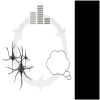The Future of Psychology: Connecting Mind to Brain
- PMID: 19844601
- PMCID: PMC2763392
- DOI: 10.1111/j.1745-6924.2009.01134.x
The Future of Psychology: Connecting Mind to Brain
Abstract
Psychological states such as thoughts and feelings are real. Brain states are real. The problem is that the two are not real in the same way, creating the mind-brain correspondence problem. In this article, I present a possible solution to this problem that involves two suggestions. First, complex psychological states such as emotion and cognition can be thought of as constructed events that can be causally reduced to a set of more basic, psychologically primitive ingredients that are more clearly respected by the brain. Second, complex psychological categories like emotion and cognition are the phenomena that require explanation in psychology, and, therefore, they cannot be abandoned by science. Describing the content and structure of these categories is a necessary and valuable scientific activity.
© 2009 Association for Psychological Science.
Figures




References
-
- Axmacher N, Mormanna F, Fernández G, Elgera CE, Fell J. Memory formation by neuronal synchronization. Brain Research Reviews. 2006;52:170–182. - PubMed
-
- Bar M. The proactive brain: Using analogies and associations to generate predictions. Trends in Cognitive Sciences. 2007;11:280–289. - PubMed
-
- Barbas H. Specialized elements of orbitofrontal cortex in primates. Annals of the New York Academy of Sciences. 2007;1121:10–32. - PubMed
-
- Barrett LF. Feeling is perceiving: Core affect and conceptualization in the experience of emotion. In: Barrett LF, Niedenthal PM, Winkielman P, editors. Emotions: Conscious and unconscious. New York: Guilford; 2005. pp. 255–284.
-
- Barrett LF. Emotions as natural kinds? Perspectives on Psychological Science. 2006a;1:28–58. - PubMed
Grants and funding
LinkOut - more resources
Full Text Sources

